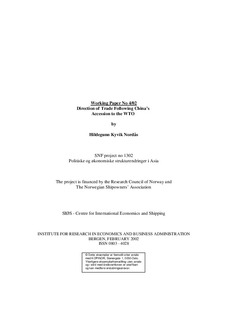| dc.description.abstract | This paper analyzes the impact of WTO accession on China’s international trade patterns. It starts with an analysis of historical trade patterns and the driving forces behind them. It is argued that China’s trade has been dominated by foreign firms located in special economic zones, particularly in the electronics sector and other technologically advanced sectors. The paper continues with a discussion of China’s WTO accession protocol and the changes in trade policy that it implies. It is argued that China’s WTO accession can largely be seen as a unilateral reduction in tariffs and non-tariff trade barriers on the part of China, with one important exception; the textile and clothing industry. China will face substantially lower trade barriers in the European and North American markets in these two sectors and China will be able to double its world market share in the apparels industry, both at the expense of other developing countries and highly protected firms in the US and EU. Other developments are a widening Chinese trade surplus towards North America, and a widening trade deficit towards Asia. However, China’s overall world export market share will not change much. These quantitative estimates are derived by running the GTAP world general equilibrium model. | en |
